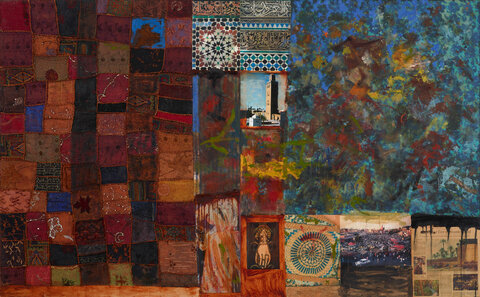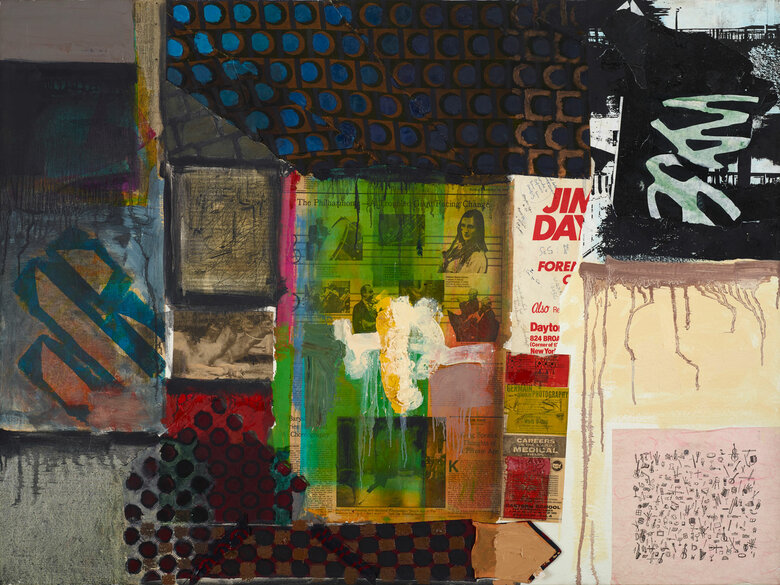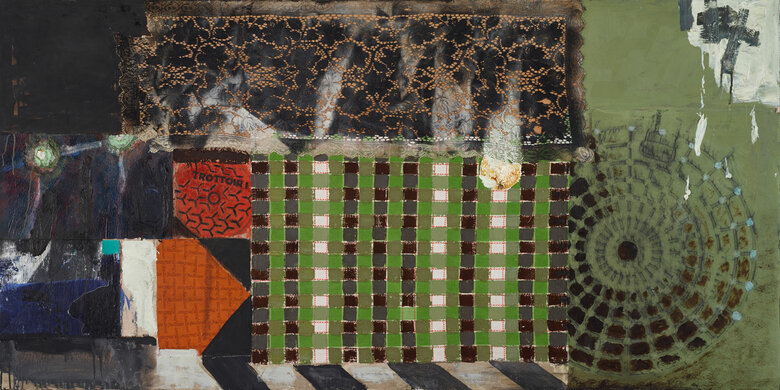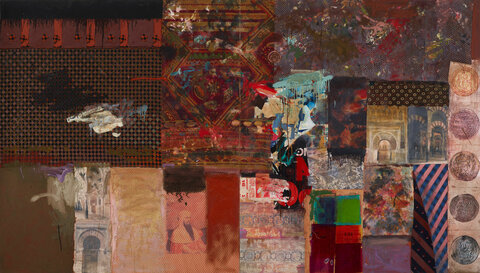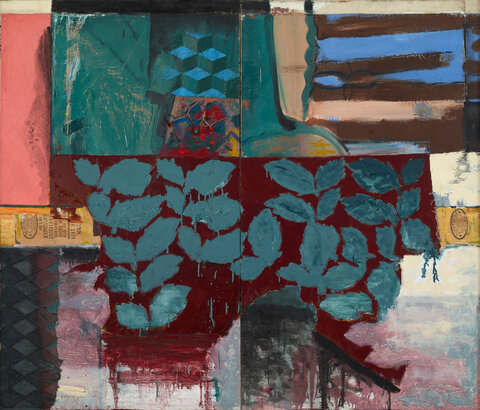Written by Mysa Kafil-Hussain “My homeland exists in my nails, it expresses itself whenever I create an artwork.” Mohammad Omar Khalil[1] Born in 1936 in Khartoum, the capital of Sudan, Mohammad...
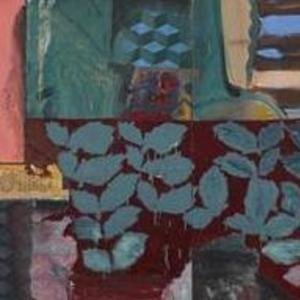

MOHAMMAD OMAR KHALIL, Sudan (1936)
Bio
Written by Mysa Kafil-Hussain
“My homeland exists in my nails, it expresses itself whenever I create an artwork.”
Mohammad Omar Khalil[1]
Born in 1936 in Khartoum, the capital of Sudan, Mohammad Omar Khalil is now an internationally esteemed painter, collage artist and master printmaker. Khalil spent much of his early life in Khartoum, and went on to study in the city’s School of Fine and Applied Arts, where he graduated in 1959 with a Diploma in Painting.[2] He then began teaching at the same institution, reaching the position of Head of Painting, but left several years later to pursue further education abroad. In 1963, Khalil enrolled into the Academy of Fine Arts in Florence, Italy; where he learnt a range of skills including mosaic art, fresco painting and printmaking. Upon leaving Italy, Khalil returned briefly to Sudan where he became Head of Painting at the Khartoum Technical Institute, remaining there for less than a year before moving on to new pastures. Khalil arrived in New York in 1967, where he still lives and works to this day.
New York marked a new start for Khalil and a new world of possibility, with the bustling city’s bright lights and creative spirit providing the artist with much inspiration, and he felt right at home: “I loved the speed, and the ideas that were happening right and left. I decided that if I had to be an artist, this was the right place. It had to be New York.”[3] New York influenced his work immensely, especially in his growing incorporation of elements of Western pop culture and the almost-synesthetic impact of American soul and jazz music. However, despite his love for his new home, he still returned to Sudan and the wider Arab region as much as possible.[4] Khalil began working in New York’s Pratt Institute and The New School in the early 1970s, teaching printmaking in these world-renowned institutions.[5] In 1978, the ground-breaking Asilah Festival took place for the first time in Morocco, first initiated by Moroccan artist Mohammed Melehi, with Khalil not only taking part as an artist but also held the position of Head of Studios, leading workshops in engraving for other artists attending the festival. Khalil soon bought a home in the old city, and still returns to Asilah every year to take part in the festival and, according to residents, enjoys walking leisurely around the beautiful, narrow paths of the small coastal city.[6]
In 1988, a disastrous flood submerged Khartoum, destroying a great deal of the city including Khalil’s hometown. Unfortunately, much of the artist’s work that he had produced in the 1960s between Sudan and Italy was destroyed, including hundreds of prints and paintings. A large segment of Khalil’s early art collection was thus lost forever.[7] Around the same time, Khalil was producing some of his most celebrated prints, including his Petra series, which he made between the 1980s-90s following a visit to the famous Jordanian site. He created diptychs and triptychs inspired by the magic and light of Petra, exuding a delicate and ethereal darkness which he also uses in much of his other prints, including other series’ in the 1990s such as Harlem and other works dedicated to cities which inspired him across the world. This mysterious darkness, in which he experimented with endless, rich gradations of black and white, allowed his imagination to run riot in his search for light, exploring – in his own words – the “pits where I found myself more liberated than ever”[8], seeing vivid colours within the darkness.
Whilst he didn’t stop creating his unique prints, upon the turn of the 21st Century Khalil seemed to allow bright and bold colours back into his work in a wide range of paintings and collages, which he produced over many years. These artworks were inspired by many influences – music, politics, personal experience, just to name a few. However, the vast majority were inspired by Khalil’s travels, especially to Morocco and southern Spain. Five of these artworks can be found in the Dalloul Collection: Desert Music (2003), Troittor I (2003), Shift III (2003), Marrakech Fana Mosque (2010) and Cordoba (2010), all of which are made with oil paint and collage on wood, allowing the viewer into a world full of textures, materials, colours and abound with energy and stories. Whilst the three paintings from 2003 are some of his earliest forays into vibrant collage work, by the time he created both Marrakech Fana Mosque and Cordoba, he was well versed in visually manifesting the sights, sounds and atmospheres of places through a spontaneous patchwork of images, fabrics and paint. His trips to Morocco, a place close to his heart, had a great impact on him over many decades, and gave him an intimate knowledge of the aesthetics of the country, as is evident in his Marrakech artwork. For Khalil, the streets of the city were a constant source of inspiration, whether it was the tile work, the textiles or just the trees and door knockers – together, he would transform all the bits and pieces he collected with his own hands until they would find their place in his collage to evoke the senses of the city.[9]
Cordoba was born out of a similar story, but the trip Khalil found himself on in the south of Spain was actually a unique group adventure with fellow artists Ibrahim El-Salahi, Dia al-Azzawi and art collector, AbdulMagid Breish. In the spring of 2009, Khalil was on sabbatical from his teaching in New York and travelled to Paris to research Paolo Uccello (which inspired a further series of collage works by Khalil under the title of Uccello’s 15th Century masterpiece, The Battle of San Romano). Breish, knowing that Khalil was in Europe, invited him to join the trip, and the group travelled together throughout Andalusia to inspire their disparate art practices.[10] Khalil was deeply moved by this journey, and once he returned home, “the art poured out, directly onto the canvas”.[11] Incorporating patterns, textures and colours inspired by Cordoba, Khalil created a snapshot of his vision of the city, also using photographs of the city’s famous Mosque-Cathedral, given to him by Azzawi after Khalil’s camera was unfortunately stolen.
There are many reasons why Khalil’s work stands out so clearly over so many decades. His paintings, etchings and collages have been described as traveler’s diaries, with the artist living “deeply in every moment of his travel” with music emanating from his images,[12] and so many of his works exude a personal touch in the details of the fabrics collected for his collages, the expressive brushstrokes in his paintings, and the magical darkness and light etched into his prints. The character and universality of his artwork move rhythmically from Khartoum to Marrakech to Andalusia and to New York and beyond, marking him not just as a Sudanese, African, or Arab artist but as an international master of his field, with his work naturally finding a home in countless global institutions and collections.
Khalil continues to live and work in New York City, and still exhibits across the world.
[1] The Mosaic Rooms, “Exhibition Guide: Mohammad Omar Khalil – ‘Homeland Under My Nails’”, The Mosaic Rooms, London, 2020, https://13rf5f1h78h24flvaf33gx6s-wpengine.netdna-ssl.com/wp-content/uploads/Exhibition-Guide-MOK.pdf
[2] Albareh Art Gallery, “Mohammad Omar Khalil”, Albareh Art Gallery, Bahrain, n.d., http://www.albareh.com/en/artists/biography/8.html
[3] The Mosaic Rooms, “Exhibition Guide: Mohammad Omar Khalil – ‘Homeland Under My Nails’”
[4] Farouk Yousif, “محمد عمر خليل المسافر الأقل خبرة في التفاؤل”, Al-Arab, September 10, 2016, https://alarab.co.uk/محمد-عمر-خليل-المسافر-الأقل-خبرة-في-التفاؤل
[5] Albareh Art Gallery, “Mohammad Omar Khalil”
[6] Yousif, “محمد عمر خليل المسافر الأقل خبرة في التفاؤل”
[7] The Mosaic Rooms, “Exhibition Guide: Mohammad Omar Khalil – ‘Homeland Under My Nails’”
[8] Abdul Aziz Ashour, “محمد عمر خليل: ذاع صيته في الغرب ووجد ضالته في الشرق”, Al-Sharq Al-Awsat, June 27, 2012, https://archive.aawsat.com/print.asp?did=682319&issueno=12256
[9] Roula El Zein, “‘A Bridge Between Two Worlds: Mohammed Omar Khalil”, Mohammad Omar Khalil: A Bridge Between Two Worlds (Exhibition Catalogue, Albareh Art Gallery, Bahrain), 2014, https://issuu.com/albareh/docs/albareh-mok-brochure
[10] Mohammad Omar Khalil, “Andalusia”, in In Vested Interests: from Passion to Patronage: The AbdulMagid Breish Collection of Arab Art, ed. Louisa Macmillan (Milan: Skira, 2020), 225
[11] Ibid
[12] Yousif, “محمد عمر خليل المسافر الأقل خبرة في التفاؤل”
Sources
Albareh Art Gallery: “Mohammad Omar Khalil”. Albareh Art Gallery, Bahrain. Accessed September 2020. http://www.albareh.com/en/artists/biography/8.html
Ashour, Abdul Aziz. “محمد عمر خليل: ذاع صيته في الغرب ووجد ضالته في الشرق”. Al-Sharq Al-Awsat. June 27, 2012. Accessed September 2020. https://archive.aawsat.com/print.asp?did=682319&issueno=12256
El Zein, Roula. “‘A Bridge Between Two Worlds: Mohammed Omar Khalil”. Mohammad Omar Khalil: A Bridge Between Two Worlds (Exhibition Catalogue, Albareh Art Gallery, Bahrain). 2014. Accessed September 2020. https://issuu.com/albareh/docs/albareh-mok-brochure
Elkayal, Heba. “For Sudanese Artist Mohammad Omar Khalil, Black Is All Color”. Al-Fanar Media. March 30, 2020. Accessed September 2020. https://www.al-fanarmedia.org/2020/03/for-sudanese-artist-mohammad-omar-khalil-black-is-all-color/
Khalil, Mohammad Omar. “Andalusia”. In In Vested Interests: from Passion to Patronage: The AbdulMagid Breish Collection of Arab Art, ed. Louisa Macmillan, p. 225. Milan: Skira, 2020.
The Mosaic Rooms: “Exhibition Guide: Mohammad Omar Khalil – ‘Homeland Under My Nails’”, The Mosaic Rooms, London. 2020. Accessed September 2020. https://13rf5f1h78h24flvaf33gx6s-wpengine.netdna-ssl.com/wp-content/uploads/Exhibition-Guide-MOK.pdf
Yousif, Farouk. “محمد عمر خليل المسافر الأقل خبرة في التفاؤل”. Al-Arab. September 10, 2016. Accessed September 2020. https://alarab.co.uk/محمد-عمر-خليل-المسافر-الأقل-خبرة-في-التفاؤل
CV
Selected Solo Exhibitions
2022
Home, MMoCA, Madison Museum of Contemporary Art, Wisconsin, USA
2020
Homeland Under My Nails, The Mosaic Rooms, London, United Kingdom
2019
You Don’t Have To Be, Aicon Gallery, New York, United States of America
2018
Andalousie, Albareh Gallery, Manama, Bahrain
2016
Suakin, Albareh Gallery, Manama, Bahrain
2015
The Nile | A River of Continuous Inspiration, Almasar Gallery, Cairo, Egypt
2014
Mohammad Omar Khalil: 50 Years of Printmaking, Contemporary Art Platform (CAP) Kuwait, Kuwait City, Kuwait
2012
A Bridge Between Two Worlds, Albareh Gallery, Manama, Bahrain
2010
Fifty Years of Printmaking, Albareh Gallery, Manama, Bahrain
The Battle of San Romano, Albareh Gallery, Manama, Bahrain
2008
You Don’t Have To Be, Skoto Gallery, New York, United States of America
Recent Works, Albareh Gallery, Manama, Bahrain
2004
Hassan II Centre for General Encounters, Asilah, Morocco
Galerie Hakim, Asilah, Morocco
2002
Rochan Fine Arts, Jeddah, Saudi Arabia
Skoto Gallery, New York, United Arab Emirates
2001
Hunterdon Museum of Art, Clinton, New Jersey, United States of America
1992
Alif Gallery, Washington D.C., United States of America
Galerie Teinturerie, Paris, France
Institut du Monde Arabe, Paris, France
Al-Wasiti Gallery, Amman, Jordan
1986
Bronx Museum of the Arts, New York, United States of America
Alif Gallery, Washington D.C., United States of America
Marlene Eleini Gallery, London
1984
Limited Art Editions, New York, United States of America
1981
New School University, New York, United States of America
New York Cinque Gallery, United States of America
1979
Galerie Basamat, Casablanca, Morocco
Galerie Structure, Rabat, Morocco
Galerie Layla Farawi, Casablanca, Morocco
1960
Khartoum, Sudan
Selected Group Exhibitions
2023
Of Mythic Worlds: Works from the Distant Past through the Present, The Drawing Center, New York, USA
2021
Creating Community. Cinque Gallery Artists, Art Students League of New York, Midtown, New York, USA
Converging Lines: Tracing the Artistic Lineage of the Arab Diaspora in the U.S., MEI Art Gallery, Middle East Institute, Washington D.C., District Of Columbia, USA
Cities Under Quarantine: The Mailbox Project, Villa Romana, Florence, Italy
2020
You Will Know Me: Migration Stories, Art Alive Gallery, Delhi, India
2017
Around The World Through Tondos, Galerie Claude Lemand, Paris, France
Ten Printmakers, National Arts Club, New York, United States of America
Seed for History and Form – Tebhaga, New York, United States of America
2016
Arab Print: Volume II, Meem Gallery, Dubai, United Arab Emirates
2015
Modern Arab Masterpieces, Galerie Claude Lemand, Paris, France
2013
The Annual: 2013, National Academy Museum and School of Fine Arts, New York, United States of America
2011
Art Sudan: Ibrahim Salahi & Mohammad Omar Khalil, Meem Gallery, Dubai, United Arab Emirates
2010
Sajjil: A Century of Modern Art, Mathaf: Arab Museum of Modern Art, Doha, Qatar
2009
Faces and Letters, Virginia Commonwealth University School of the Arts, Doha, Qatar
2008
Tawasel/Continuity: Contemporary Artists from Sudan, Virginia Commonwealth University of the Arts, Doha, Qatar
Word into Art: Artists from the Modern Middle East, British Museum, London, United Kingdom
2007
Contemporary Print, Albareh Art Gallery, Manama, Bahrain
Art Inspired by Poetry, Darat Al Funun, Amman, Jordan
2006
Word into Art: Artists of the Modern Middle East, British Museum, London, United Kingdom
2003
Broken Letter: Contemporary Art from Arab Countries, Kunsthalle Darmstadt, Darmstadt, Germany
2002
Perspective on Contemporary Arab Art: The Kinda Foundation Collection, Institute du Monde Arabe, Paris, France
1994
Mohammed Omar Khalil: Etchings / Amir I.M. Nour: Sculpture, National Museum of African Art, Washington D.C., United States of America
1993
Herbert F. Johnson Museum of Art, Cornell University, Ithaca, New York, United States of America
International Biennial of Cairo, Cairo, Egypt
1992
Alif Gallery, Washington D.C., United States of America
1991
Osaka Triennial Fifth International Biennial Print Exhibition, Taipei, Taiwan
University of Hawaii, Hilo, Hawaii
1990
International Monetary Fund Centre, Washington D.C., United States of America
1989
Barbican Centre, London, United Kingdom
Centre Cultural Ranco, Oslo, Norway
1988
Al-Wasiti Gallery, Amman, Jordan
Sudan Art Aid, Sudan Cultural Centre, London, United Kingdom
1987
June Kelly Gallery, New York, United States of America
1986
The First Baghdad International Festival of Art, Saddam Arts Centre (formerly the National Museum of Modern Art), Baghdad, Iraq
Alif Gallery, Washington D.C., United States of America
1985
International Triennial of Original Graphic Prints, Grenchen, Switzerland
Toledo Museum of Art, Ohio, United States of America
Columbia Museum of Art, South Carolina, United States of America
1984
El Paso Museum of Art, Texas, United States of America
Tacoma Art Museum, Washington D.C., United States of America
Seventh Norwegian Print Biennial, Fredrickstad, Norway
African-American Museum of Life and Culture, Dallas, Texas, United States of America
1980
Third World International Exhibition, London, United Kingdom
Awards
2003
First Prize in Printmaking, National Academy of Design, New York, United States of America
2001
First Prize in Printmaking, National Academy of Design, New York, United States of America
1997
Teaching Excellence Award, New School University, New York, United States of America
1993
First Prize, International Biennial of Cairo, Cairo, Egypt
1991
Bronze Medal, Osaka Triennial Fifth International Biennial Print Exhibition, Osaka, Japan
1987
Counsel of the Arts Grant, Bronx Museum of the Arts, New York, United States of America
1980
Third Prize, Third World International Exhibition, London, United Kingdom
1979
Purchase Award, Society of American Graphic Artists, New York, United States of America
1978
Louise Comfort Tiffany Foundation Grant, New York, United States of America
Collections
AbdulMagid Breish Collection of Arab Art, London, United Kingdom; Tripoli, Libya
Barjeel Art Foundation, Sharjah, United Arab Emirates
Bibliotheque National de France, Paris, France
British Museum, London, United Kingdom
Bronx Museum of the Arts, New York, United States of America
Brooklyn Museum, New York, United States of America
Musée de Grenoble, Grenoble, France
Institut du Monde Arabe, Paris, France
Jordan National Gallery of Fine Arts, Amman, Jordan
Library of Congress, Washington D.C., United States of America
Metropolitan Museum of Art, New York, United States of America
Museum of History, Taipei, Taiwan
Museum of Modern Art, Osaka, Japan
National Museum of African Art: Smithsonian Institution, Washington D.C., United States of America
Press
Return to Print . Mohammad Omer Khalil . Sudanese artists talks of his journeys . _ Dalloul Art Foundation.pdf
محمد عمر خليل_ ذاع صيته في الغرب ووجد ضالته في الشرق.pdf
الفنان العالمي محمد عمر خليل يتلاعب بالكولاج خارج إطار الزمن.pdf
«جسر بين عالمين» معرض السوداني محمد عمر خليل في غاليري البارح - صحيفة الأيام البحرينية.pdf
شاهد صوراً لأعمال الفنان التشكيلي السوداني محمد عمر خليل البحرين - صحيفة الوسط البحرينية - مملكة البحرين.pdf
Al Rai.pdf
التشكيلي محمد عمر خليل.. تعبيرات صادقة بريشة ملونة.. في معرض الفرنسي - صحيفة الراكوبة.pdf
AL MASAR GALLERY Contemporary Art.pdf
Alwanforthearts.pdf
الحياة - معرض للفنان السوداني محمد خليل_ خمسون عاماً من الحفر.pdf
ALArab.pdf
محمد عمر خليل_ بورتريهات ذاتية نجت من الطوفان.pdf
mohamed omar khalil.pdf
Africanah.pdf
السوداني محمد عمر خليل يفوز بجائزة النيل للمبدعين العرب - أخبار مصر - الوطن.pdf
الحياة - معرض للفنان السوداني محمد خليل_ خمسون عاماً من الحفر.pdf
تعرف على الفنان السودانى محمد عمر خليل الفائز بجائزة النيل للمبدعين العرب - اليوم السابع.pdf
شاهد صوراً لأعمال الفنان التشكيلي السوداني محمد عمر خليل البحرين - صحيفة الوسط البحرينية - مملكة البحرين.pdf
التشكيلي محمد عمر خليل.. تعبيرات صادقة بريشة ملونة.. في معرض الفرنسي - صحيفة الراكوبة.pdf
Mohammad Omer Khalil.pdf
من هو الفنان السوداني محمد عمر خليل الفائز بجائزة النيل للمبدعين العرب؟.pdf
MOHAMMAD OMAR KHALIL Artwork
Become a Member
Join us in our endless discovery of modern and contemporary Arab art
Become a Member
Get updates from DAF
Follow Artists
Save your favourite Artworks
Share your perspectives on Artworks
Be part of our community
It's Free!
We value your privacy
TermsCookiesPrivacy Policies
Become a Member
Get updates from DAF
Follow Artists
Save your favourite Artworks
Share your perspectives on Artworks
Be part of our community
It's Free!
We value your privacy
TermsCookiesPrivacy Policies
Become a Member
Get updates from DAF
Follow Artists
Save your favourite Artworks
Share your perspectives on Artworks
Be part of our community
It's Free!
We value your privacy
TermsCookiesPrivacy Policies
Welcome to the Dalloul Art Foundation
Thank you for joining our community
If you have entered your email to become a member of the Dalloul Art Foundation, please click the button below to confirm your email and agree to our Terms, Cookie & Privacy policies.
We value your privacy, see how
Become a Member
Get updates from DAF
Follow Artists
Save your favourite Artworks
Share your perspectives on Artworks
Be part of our community
It's Free!
We value your privacy
TermsCookiesPrivacy Policies


